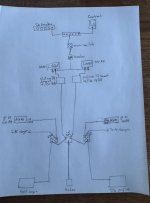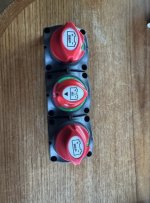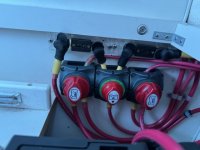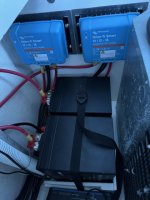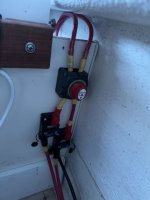As Thataway wrote a while ago, there is no "right way" or perfect way of designing this.
I am not an EE nor do I hold any ABYC certification.
A few notes though, mostly in the form of more questions:
Why move the start batteries?
For many reason but here’s a few, I have a lot of corrosion in the wiring and switches, enough to create issues so engines won’t start. I had a very similar scenario on my 22 (14 YO at the time) any wiring inside the cabin is/was still in like new condition. I’m aiming for a do it right, do it once. The marine inspector recommended to address the drip around the batteries. It’s, coming from the hatch mostly maybe a cup or two per rainy day, enough to keep things damp. I also would like to move weight forward, and increase the available storage in the cockpit.
MRBF on a start battery: Most people obviously do not run fuses on the start circuit. I do think it is a good idea in theory. I would base the rating on whatever your outboard's starters are rated at + a margin of error, or the current carrying capacity of the wire, whichever is higher.
Because it will be a longer run, I would feel better if it was protected, I have not found a reliable answer on the starter draw, I can test this in the spring.
You don't show it, but MBRFs on the LiFePo4 batteries is also a good idea. I know there is some debate on this, but I use them with LiFePo4 w/ built in BMS.
It’s not very clear on my drawing but I do have MBRF on each of the LiFePo4, then to the main breaker.
You don't show any of the wire gauges, which would provide more context for what you are planning. 60A is quite light to run the entire boat, especially if you have a windlass. I believe my windlass is on a 50A breaker on its own, but perhaps you are leaving the windlass connected to the start batteries? I also assume you have no intent of adding an inverter or inverter/charger?
For the bulk of this, I will be using 4AWG, probably bigger for the leg to the engines starter. The 60A breaker will have the house load minus the windlass and line hauler. No plan to add an inverter.
Also not sure how your kicker is wired into your 1-2-both switch? I'm also not sure what your intention is with the way the switch is drawn. Might just be my misunderstanding of the drawing.
 I will be using a BEP cluster switch. A port and starboard on/off switch and a 1/2/both/off switch. That allow me to jump start one battery with the other, have one engine charge either or both batteries. I’ll have the kicker to the common terminal, can use either battery to start it or have the kicker charge either start with or separate of the house bank. Hope that make more sense.
I will be using a BEP cluster switch. A port and starboard on/off switch and a 1/2/both/off switch. That allow me to jump start one battery with the other, have one engine charge either or both batteries. I’ll have the kicker to the common terminal, can use either battery to start it or have the kicker charge either start with or separate of the house bank. Hope that make more sense.
Finally, for wiring simplicity, I would personally only run one DC-DC charger, and I would put the two LiFe4Po batteries on a similar 1-2 switch so they can be isolated and disconnected (suggested by ABYC.)
I really like the idea of the 1-2 switch, thanks, I will add this to my plan. The reason behind having 2 dc/dc charger is that each alternator is putting a charge on the house bank.

